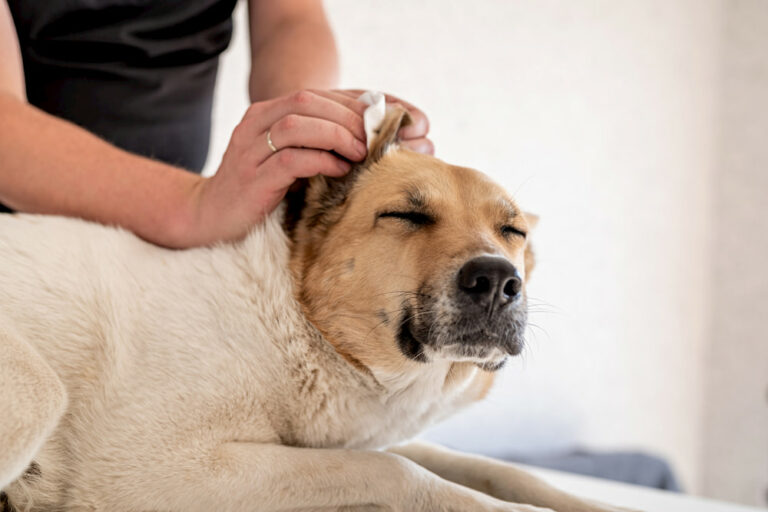Frequently Asked Questions
Why is my dog itchy?
The most common cause of itching in dogs is one or more underlying allergies. Parasites, infection and dry skin can also cause or contribute to itch. A number of other diseases unrelated to allergies can also cause itching.
Itchy dogs may scratch with their back legs; chew, nibble and lick their body or feet; scoot on their bottoms; or rub themselves on the ground and against furniture. Dogs with itchy ears may flap their heads & scratch their ears with their back legs. The skin may look normal or you may see signs of inflammation or evidence of self-trauma (scratch marks, sores and bald patches).
By process of elimination and diagnostic tests, we can rule out the various factors that may be causing or contributing to your pets itch to get to the underlying root cause. We can also perform allergy testing to identify what your dog is allergic to.
Why does my dog keep getting ear infections?
There are 2 main reasons your pet’s ear infection keeps coming back:
- The infection resolved but recurred due to an underlying trigger such as an allergy (true recurring infection)
- The infection never completely completely resolved in the first place (chronic infection)
Whether your pets ear infection is recurring or chronic, the approach to treatment is the same:
- The current infection must be treated until completely resolved
- Recurrence is prevented by identifying & managing underlying triggers or managing inflammation caused by the triggers
Successful treatment of chronic ear infections requires selecting the correct medications, treating for the appropriate period of time, ensuring the medication is reaching down to the end of the ear canal and reducing inflammation and swelling. Flushing out debris & wax plugs under anaesthesia and ruling out middle ear infection may also be necessary.
Left untreated, chronic ear infections can lead to irreparable damage to the ear canal, requiring surgery.
Are ear infections painful?
 Ear infections can be painful due to inflammation & damaged skin. In humans, the pain is described as either sharp & sudden or dull & continuous and there may be a feeling of pressure inside the ear. Dogs show discomfort by shaking their head, tilting their head to one side, scratching or rubbing the ear, whinning, yelping or avoiding having the ear touched or looked at. The sooner appropriate treatment is started, the sooner your dog can be given relief from the itching and pain.
Ear infections can be painful due to inflammation & damaged skin. In humans, the pain is described as either sharp & sudden or dull & continuous and there may be a feeling of pressure inside the ear. Dogs show discomfort by shaking their head, tilting their head to one side, scratching or rubbing the ear, whinning, yelping or avoiding having the ear touched or looked at. The sooner appropriate treatment is started, the sooner your dog can be given relief from the itching and pain.If your dog is suffering from an ear infection or ear pain, please seek veterinary attention as soon as possible. Do not put anything inside the ear that isn’t formulated for active infections such as over-the-counter or homemade ear solutions as these may be acidic or contain alcohol which may sting and worsen the pain.
What is Fear Free?
 Many animals have learned to associate vet visits with pain and fear. In addition, many animals with chronic skin disease also suffer from anxiety.
Many animals have learned to associate vet visits with pain and fear. In addition, many animals with chronic skin disease also suffer from anxiety.A Fear Free approach means making all efforts to prevent and alleviate fear, anxiety or stress during your pet's visit. It requires first recognising the signs of fear & stress, many of which are commonly overlooked or misunderstood, then acting accordingly. Strategies to reduce fear include giving treats, praise, pats, speaking in a calm and reassuring voice, giving the animal space, adjusting the environment, handling with ‘low-restraint’ and most importantly, avoiding punishment, intimidation and force.
Anti-anxiety medications are also useful for many patients; These improve the emotional state and learning pathways in the brain so that new positive associations can be formed at a faster rate. If your pet would benefit from anti-anxiety medication, we can prescribe them for you to administer prior to your pet’s visit. Anti-anxiety or calming medication can also be useful for other purposes, such as applying ear medications in a dog who has had previously bad experiences.
Anxious dogs may also benefit from a home visit so they can be examined and treated in a familiar environment, where they feel comfortable.
To learn more about fear and anxiety in dogs, including understanding how fear can lead to aggression, view or download our free information handout here.
The Fear Free approach requires a little more time and patience than the traditional approach, but the end result is veterinary care which is kinder and less stressful in the long run for both animal and human.
What is the benefit of specialised care?
While most general practitioners can provide diagnosis and treatment for many skin diseases, dermatologists and general practitioners with a special interest in dermatology have additional skills, knowledge and experience, which enable them to diagnose and manage a wide range of skin diseases including complex, rare and unusual cases. Animals with allergies also benefit from specialised care due to the chronic and recurring nature of allergic skin disease.Time constraints and lack of continuity in general practice may also pose limitations in some circumstances. Skin cases usually have a long medical history which benefits from review, in order to determine the response to previous treatments and identify patterns. This helps guide future decisions.Skin cases are often also complicated by secondary infection and have more than one underlying cause so it can take time to work through these to get to the bottom of the problem.Furthermore, successful management of skin disease often relies on multimodal therapy (using a combination of different approaches). It can take time to work through these various treatment options in order to find a plan with the right balance; one that not only improves the disease but also considers other factors such as time or financial constraints and the animal’s emotional wellbeing.Are revisits necessary?
 Revisits are critical to achieving successful long term management of chronic skin disease. Every skin case is unique and requires an individualised plan tailored to the patient and the owner based on response to treatment, practicality and financial considerations.
Revisits are critical to achieving successful long term management of chronic skin disease. Every skin case is unique and requires an individualised plan tailored to the patient and the owner based on response to treatment, practicality and financial considerations.In the initial stages of treatment, revisits may be as frequent as every 2-4 weeks. Once stable, frequency typically reduces to monthly, then to 3 or even 6 months.
Failing to return for revisits often means having to start all over again when the problem recurs. In addition, as the disease becomes more advanced, response to treatment may not be as effective as in earlier stages and may require more extensive treatment to get things back under control.
Being proactive and following the treatment plan (including revisits) allows you to reach the management stage of the treatment plan faster and helps prevent your pet’s skin condition from becoming progressively difficult to manage.
Will my regular vet be involved?
We maintain good communication with other veterinarians involved in your pet’s care. After each visit, a clinical summary is emailed to you and your regular vet. We also liaise with other vets to offer advice as needed and work together as a team.
Will pet insurance cover my visit?
As long as your pet insurance policy is not limited to ‘accident only’ and does not have dermatologic (including ear) problems listed as pre-exisiting conditions, you should be able to be claim and be reimbursed for your consultation & medication costs. However, food, supplements and non-medicated shampoos are not typically covered. Please read your policy for further information.
Please let us know if you have pet insurance, and we will do our best to make sure your insurance claim is processed as smoothly and as straight forward as possible.